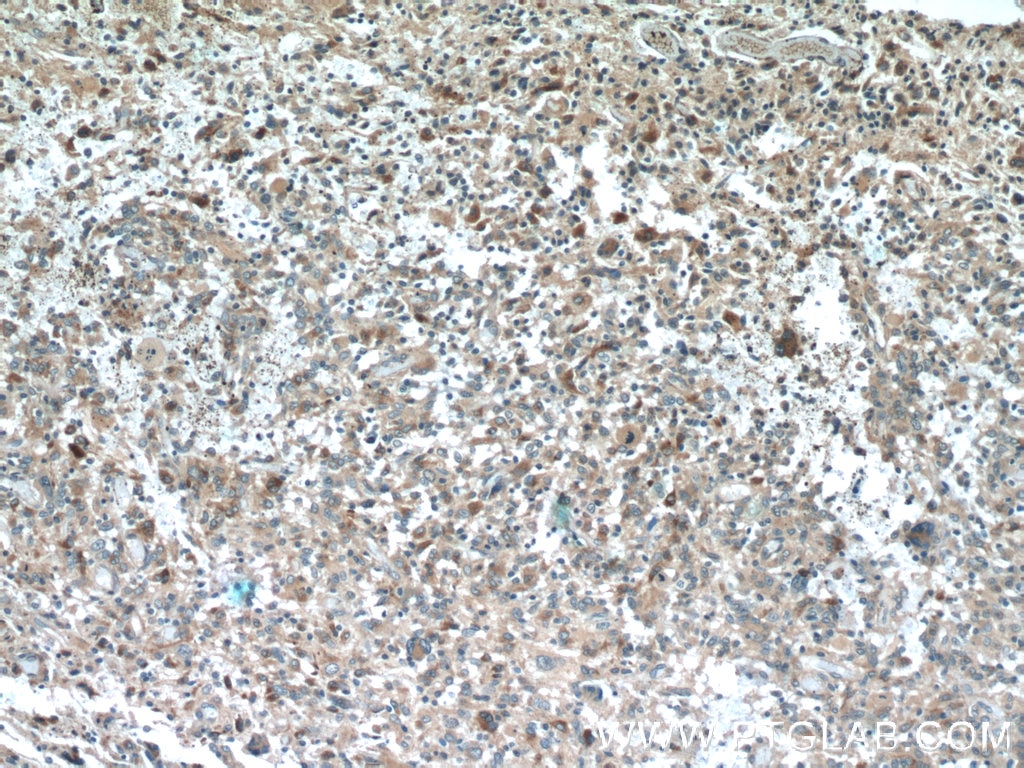Tested Applications
| Positive WB detected in | human heart tissue |
| Positive IP detected in | Raji cells |
| Positive IHC detected in | human tonsillitis tissue, human gliomas tissue Note: suggested antigen retrieval with TE buffer pH 9.0; (*) Alternatively, antigen retrieval may be performed with citrate buffer pH 6.0 |
Recommended dilution
| Application | Dilution |
|---|---|
| Western Blot (WB) | WB : 1:500-1:2000 |
| Immunoprecipitation (IP) | IP : 0.5-4.0 ug for 1.0-3.0 mg of total protein lysate |
| Immunohistochemistry (IHC) | IHC : 1:50-1:500 |
| It is recommended that this reagent should be titrated in each testing system to obtain optimal results. | |
| Sample-dependent, Check data in validation data gallery. | |
Published Applications
| WB | See 5 publications below |
| IHC | See 3 publications below |
| IF | See 1 publications below |
Product Information
13517-1-AP targets SPARCL1 in WB, IHC, IF, IP, ELISA applications and shows reactivity with human samples.
| Tested Reactivity | human |
| Cited Reactivity | human, mouse |
| Host / Isotype | Rabbit / IgG |
| Class | Polyclonal |
| Type | Antibody |
| Immunogen |
CatNo: Ag4448 Product name: Recombinant human SPARCL1 protein Source: e coli.-derived, PGEX-4T Tag: GST Domain: 316-664 aa of BC033721 Sequence: VSEALLMEPTDDGNTTPRNHGVDDDGDDDGDDGGTDGPRHSASDDYFIPSQAFLEAERAQSIAYHLKIEEQREKVHENENIGTTEPGEHQEAKKAENSSNEEETSSEGNMRVHAVDSCMSFQCKRGHICKADQQGKPHCVCQDPVTCPPTKPLDQVCGTDNQTYASSCHLFATKCRLEGTKKGHQLQLDYFGACKSIPTCTDFEVIQFPLRMRDWLKNILMQLYEANSEHAGYLNEKQRNKVKKIYLDEKRLLAGDHPIDLLLRDFKKNYHMYVYPVHWQFSELDQHPMDRVLTHSELAPLRASLVPMEHCITRFFEECDPNKDKHITLKEWGHCFGIKEEDIDENLLF Predict reactive species |
| Full Name | SPARC-like 1 (hevin) |
| Calculated Molecular Weight | 664 aa, 75 kDa |
| Observed Molecular Weight | 130-140 kDa |
| GenBank Accession Number | BC033721 |
| Gene Symbol | SPARCL1 |
| Gene ID (NCBI) | 8404 |
| RRID | AB_10598475 |
| Conjugate | Unconjugated |
| Form | Liquid |
| Purification Method | Antigen affinity purification |
| UNIPROT ID | Q14515 |
| Storage Buffer | PBS with 0.02% sodium azide and 50% glycerol, pH 7.3. |
| Storage Conditions | Store at -20°C. Stable for one year after shipment. Aliquoting is unnecessary for -20oC storage. 20ul sizes contain 0.1% BSA. |
Background Information
SPARC-like protein 1 (SPARCL1), also known as SC1 or Hevin, is an extracellular matrix glycoprotein that belongs to the SPARC family. SPARCL1 is widely expressed in normal and cancer tissues, and has been shown to regulate cellular adhesion and migration. SPARCL1 has been implicated in tumor initiation, formation, and progression of various cancers, including pancreatic, prostate, bladder, ovarian, breast and non-small cell lung cancers.
Protocols
| Product Specific Protocols | |
|---|---|
| IHC protocol for SPARCL1 antibody 13517-1-AP | Download protocol |
| IP protocol for SPARCL1 antibody 13517-1-AP | Download protocol |
| WB protocol for SPARCL1 antibody 13517-1-AP | Download protocol |
| Standard Protocols | |
|---|---|
| Click here to view our Standard Protocols |
Publications
| Species | Application | Title |
|---|---|---|
CNS Neurosci Ther Endothelial genetic deletion of CD147 induces changes in the dual function of the blood-brain barrier and is implicated in Alzheimer's disease. | ||
J Neurochem Defective Synthesis and Release of Astrocytic Thrombospondin-1 Mediates the Neuronal TDP-43 Proteinopathy Resulting in Defects in Neuronal Integrity Associated with Chronic Traumatic Encephalopathy: In Vitro Studies. | ||
Cancer Biomark Integrated analysis reveals down-regulation of SPARCL1 is correlated with cervical cancer development and progression | ||
PLoS One Secreted protein acidic and rich in cysteine (SPARC) knockout mice have greater outflow facility. | ||
J Chem Neuroanat Olfactory ensheathing cells facilitate neurite sprouting and outgrowth by secreting high levels of hevin. |














